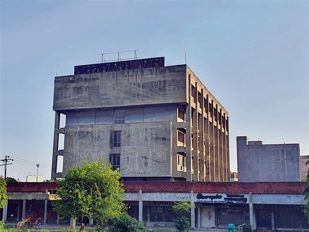
Fire hose cabinet contains axe,extinguisher,fire hose.
Raj Kumar Aggarwal
The increasing frequency of fire hazards in major public, commercial, industrial and high rise buildings is alarming. Maximum number of fire instances in commercial or residential building are caused by electric short circuit. While, preventing fire accidents is one of the most important aspects of building maintenance services, a buyer or a resident is usually kept in the dark by the builder about the systems put in place for a fire emergency. Usually the hydrants are sub standard, the water storage is not attached to the hydrants, fire exits are blocked. So, it is imperative for every buyer and building user to know exactly what is being dished out to him in the name of a fire fighting system. Here are some points that you should know about:
Components of an efficient system
A fire-fighting system consists of mainly three units. A large store of water in tanks, either underground or on a roof top of the building called fire storage tanks; a specialised pumping station; and a network of water pipes for fire hydrants and sprinklers along with a fire alarm system.
Fire extinguisher system
A fire extinguisher is an active fire protection device used to control small fires in emergency situations. It is not intended for use on out- of-control fire requiring the expertise of a fire department. A fire extinguisher consists of a hand held cylindrical vessel containing carbon dioxide (CO2) a clean non-combustible, non-corrosive gas which extinguishes fire primarily by lowering the level of oxygen gas helpful in the burning of fire. Fire extinguisher of other types available in the market are: water type, mechanical foam type & ABC chemical powder fire extinguishers to use on specific locations.
Hydrant system
This system is the backbone of the fire protection system and is installed on every campus to meet the demand of water to combat fire. A fire hydrant is a box- type structure fitted on a vertical steel pipe with an outlet, close to which two fire hoses are stored. Internal hydrant is provided with double-braided rubber hose wound on a drum connected to the hydrant riser through a ball valve. To meet the demand of water sufficient number of hydrants are installed on the main water line laid around the building.
During a fire, fire fighters open the hose so that water rushes out of the nozzle affecting sensors to detect the drop in pressure and trigger the fire pump to start pumping water at a tremendous flow rate to fight fire.
Automatic sprinklers
Automatic sprinklers have the unique property of automatic detection, control and extinguishing of fire by releasing water automatically in required quantities over the designated areas. This is universally recognised as the most effective fire protection system for buildings and other structures. In this system, sprinklers are attached to a network of pipes installed just below the ceilings. Every sprinkler has a glass bulb full of liquid. During a fire, the liquid in the bulb expands resulting in water spray from sprinkler on the fire to combat it.
The main difference between a hydrant system & a sprinkler system is that sprinkler will spray water automatically, whereas fire hydrant has to be operated manually.
Smoke detector & automatic fire alarm
A smoke detector is a device that detects smoke of a fire. It raises a fire alarm in the event of any type of smoke or fire in commercial, industrial and mass residential buildings, whereas in small residential houses, smoke detector sounds a local audible alarm so that fire can be noticed & controlled.
What the code says
The National Building Code recommends that every building should have sufficient exits to permit easy and safe escape of public in case of a fire. All exit should be free of obstructions and properly lit up. Minimum 20 ft wide open space should be provided around the building for free movement of fire-tenders for free movement of fire-tenders in case of some fire. Adequate number of portable fire extinguishers in good working condition along with some bags of dry sand and water buckets should also be available near all suspected points of fire hazards to control fire. Fire safety certificate is must for all public buildings. It is issued by fire officer of the concerned council after inspecting the fire protection system of the building.


























